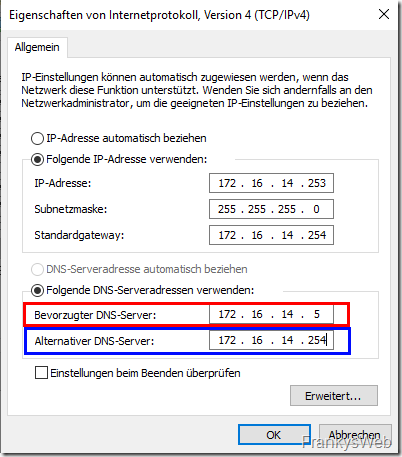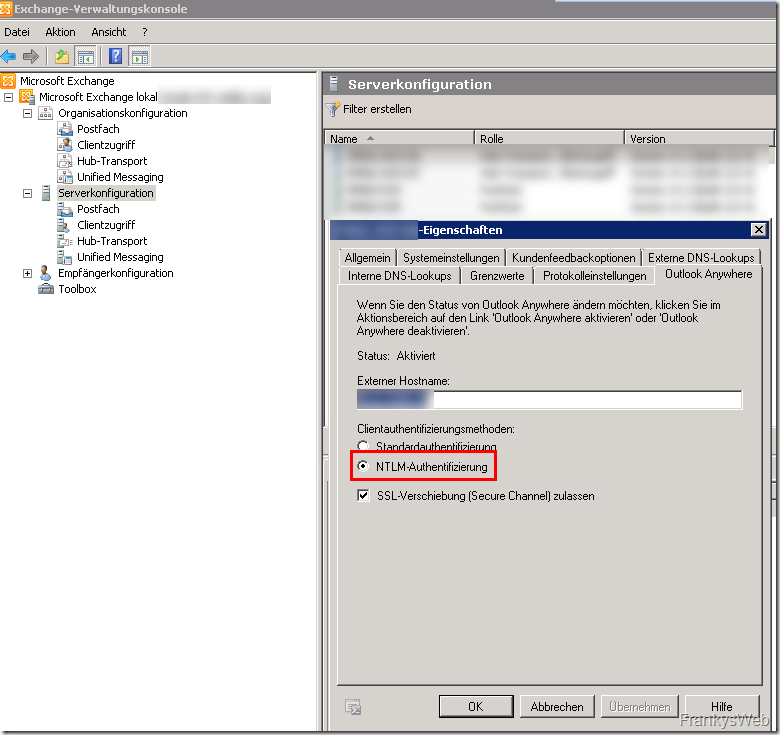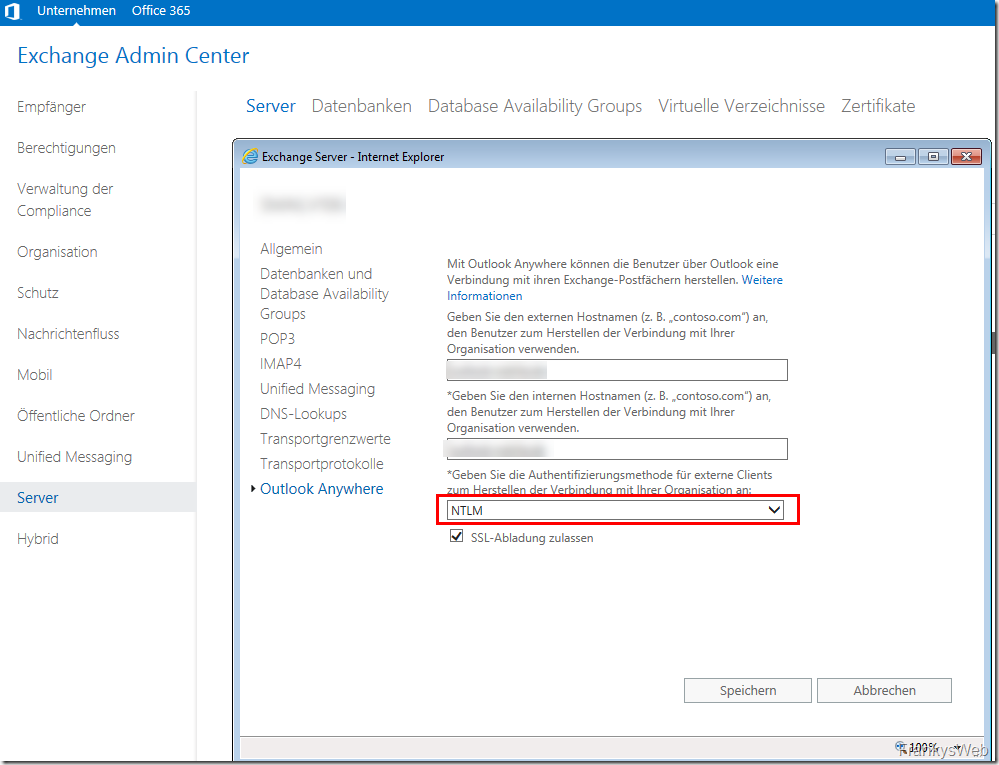In January I had already an article about problems with the Outlook connection to Exchange during the migration. In this new article, I would now like to mention a few more common causes of problems.
DNS server is not a DC
During the coexistence of the Exchange servers, users may not be able to send emails between the two Exchange versions. For example, if a user with an Exchange 2010/2013 mailbox cannot send mails to users with an Exchange 2016 mailbox, the cause may lie in the DNS settings of the Exchange servers.
The following error is then usually found in the Exchange queues:
Hub version 15 - smtp-relay in active directory - Error: 451 - 4.4.0 DNS query failed. The error was: SMTPSEND.DNS.NonExistendDomain, nonexistend domain
The cause of this problem is usually that DNS servers that are not domain controllers have been configured for the Exchange servers. Often other DNS servers such as routers cannot resolve the underscore zones (e.g. _msdcs). In this example, the router was specified as the alternative DNS server (blue), the preferred DNS server is a domain controller:
In this case, the problem described above occurs. Either the router must be configured so that the underscore zones can also be resolved, or only DNS servers that are also domain controllers and can therefore resolve the underscore zones are entered.
Public Folder Proxy on wrong server
Without a public folder proxy mailbox, users whose mailboxes have been moved to newer Exchange servers can no longer access the public folders of the Exchange 2010 servers. To enable access during the migration, one or more public folder proxy mailboxes can be used. However, I have often seen that the proxy database is deployed on the wrong server. The proxy database and the public folder proxy mailboxes must be created on the Exchange 2010 servers, not on Exchange 2013 or Exchange 2016 servers.
The following commands for creating the proxy database and a public folder proxy mailbox must be executed on an Exchange 2010 server:
| 1 2 3 | New-MailboxDatabase
-server
Exchange2010Server
-Name
PFProxyDatabase
-IsExcludedFromProvisioning
$true
New-Mailbox
-Name
PFProxyMailbox1
-Database
PFProxyDatabase
-UserPrincipalName
PFProxyMailbox1
@domain
.local
Set mailbox
-Identity
PFProxyMailbox1
-HiddenFromAddressListsEnabled
$true
|
The next command for assigning the proxy mailbox must be executed on an Exchange 2013 / Exchange 2016 server:
| 1 | Set-OrganizationConfig
-PublicFoldersEnabled
Remote
-RemotePublicFolderMailboxes
PFProxyMailbox1
|
If Outlook still does not want to display public folders, it helps to enter the proxy database as the public folder database of the Exchange 2016 database. This command can be executed in the Exchange 2013 / 2016 shell:
| 1 | Get-MailboxDatabase
|
Set-MailboxDatabase
-PublicFolderDatabase
"PFProxyDatabase"
|
In addition, the proxy mailbox can also be assigned to the migrated mailboxes:
| 1 | Set mailbox
Exchange2016Mailbox
-DefaultPublicFolderMailbox
"PFProxyMailbox1"
|
After these settings have been changed, the "Microsoft Exchange RPC Client Access Service" service must be restarted.
Different authentication settings
Different authentication settings between the Exchange Server versions also repeatedly cause problems with the Outlook connection. In particular, the settings for Outlook Anywhere should be set the same in both Exchange worlds. For example, if NTLM is configured for Outlook Anywhere on the Exchange 2010 servers, then NTLM should also be configured on Exchange 2013/2016 servers.
Here is an example of a corresponding configuration:
Certificates
The certificate for the Exchange server should be configured directly after installation and basic configuration. Certificate errors not only annoy users, but can also cause problems when connecting Outlook to Exchange.
If the Exchange URLs are retained during the migration, the certificate of the "old" Exchange servers can continue to be used for the new Exchange servers. I have described how this works here:
Of course, a new certificate is not a problem as long as it is valid and is classified as trustworthy by the clients. The following three articles can help you to configure an appropriate certificate:
- Exchange 2016: The basic configuration
- Exchange 2013: Create certificate request for public CA
- Exchange 2013: SAN certificate and internal certification authority (CA)
Thanks to the free certification authority Let's EncryptThe certificate can also be requested and imported automatically, for example with my "Certificate Assistant":



Hallo zusammen,
Get-MailboxDatabase | Set-MailboxDatabase -PublicFolderDatabase „PFProxyDatabase“
Man aktiviert für die Maiboxdatenbanken auf einem Exchange 2016 den Zugriff auf eine Exchange 2010 PublicFolderDatabase, welche aber eine normale Mailboxdatabase (die Proxy-Mailbox) ist…
Diese Funktion gibt es aber nicht auf Exchange 2016. Oder wie ist der diesbezügliche Abschnitt gemeint?
LG
Volker Hess
Hallo Volker,
konntest du das Problem lösen?
Ich stehe gerade an dem gleichen Problem und versteh diesen Teil der Anleitung auch nicht – für mich aktuell widersprüchlich…
VG
Steffen
Hallo, Frank,
“ Ich habe allerdings schon häufiger gesehen, dass die Proxy Datenbank auf falschen Server bereitgestellt wird.“
Zu denen gehöre ich leider auch… ;-)
Aber die Migration ist abgeschlossen. Kann die PFProxydatabase nun gelöscht werden (da sie ja ohnehin auf dem 2016er nichts zu suchen hat)?
Hallo Frank,
ich stehe gerade vor einem „Problem“ mit der Proxy Mailbox für die öffentlichen Ordner.
Es wird ja überall geschrieben, dass empfohlen wird, die Proxy Mailbox in einer eigenen Postfachdatenbank anzulegen.
Nun habe ich im Moment das Problem, dass bei einem Exchange 2010 Standard die 5 gemounteten Datenbanken bereits genutzt werden. Dadurch kann ich natürlich auch keine weitere Datenbank mounten.
Ist es zwingend notwendig das Proxy Postfach in einer eigenen Datenbank laufen zu lassen?
Was hat es für Nachteile wenn man das nicht tut.
Björn
Hallo Frank,
wir haben ein sehr kurioses Problem bei der Migration von 2010 auf 2016 und sind uns nicht wirklich sicher wo es genau hakt…. evtl hast du ja eine Idee…
es geht um Outlook 2010 SP2. mit EX2016, nach meiner Information benötigt man hier den KB2965295 welcher sich jedoch nicht „richtig“ installieren lässt Fehlermeldung: „Von dem auf diesem System installierten Paket sind keine Produkte betroffen“
was mir ein wenig zu denken gibt ist das im EX2010 Outlook Anywhere deaktiviert ist (will der Kunde so..) und sobald wir zum Test per hosts file auf den EX2016 zeigen bekommt OL keine Verbindung mehr mit EX2010 Mailboxen. eine Mailbox auf 2016 scheint allerdings mit dem OL2010 zu funktionieren. Sollte der Exchange 2016 hier nicht als Proxy arbeiten und Outlook an den EX2010 weiterleiten?
Grüße und vielen Dank
Daniel
Hi Frank,
ist es noch aktuell, dass Microsoft mit Exchange 2016 und 2019 die User von den öffentlichen Ordnern wegbringen will oder wurde das mittlerweile zurückgenommen?
Gruß,
Stefan
Hallo Stefan,
es war von Seitens Microsoft geplant öffentliche Ordner ab Exchange 2013 komplett abzuschaffen.
Wegen dem großen Protest vieler Unternehmen hat Microsoft die öffentlichen Ordner in ein eigenes Postfach migriert und schleift diesen Balast ohne große Weiterentwicklung mit sich weiter.
Ich finde sowohl öffentliche Ordner als auch Funktionspostfächer haben beide Ihre Vor- und Nachteile.
Vorteile öffentliche Ordner:
– keine Aufwand für die Einrichtung von neuen Postfächern/Kalender nötig (Postfach in Outlook hinzufügen usw.)
– Übersichtlicher wenn nur eine Funktion eines Postfachs gebraucht wird für z.B. einen gemeinsamen Kalender
Vorteile Funktionspostfach:
– ActiveSync wird unterstützt
– Gelesene Elemente Zähler funktioniert
– Geringerer Aufwand bei Migration
In meinem Unternehmen gehen wir immer weiter weg von öffentlichen Ordner, da Microsoft darin wohl keine Zukunft sieht. In neuen Umgebungen arbeiten wir komplett ohne öffentliche Ordner.
@Frank: Korrigiere mich, falls nötig
VG
Pascal
Hallo Frank,
vielen Dank für diesen hilfreichen Beitrag!
Gibt es denn eine bevorzugte Authentifizierungsmethode der Clients gegenüber dem Exchange Server (z.B. bei Outlook anywhere)? Oder ist es hier egal, welche man nimmt?
Danke nochmal.
Gruß, Christoph.
Hallo Christoph,
wenn möglich würde ich NTLM verwenden. Einige Firewalls und Proxys haben damit allerdings Schwierigkeiten.
Gruß,
Frank
Hallo Frank,
ergänzend zu Deinem Artikel: Ich erlebe es immer noch sehr häufig, dass der LegacyExchangeDN vergessen wird und sich dann nach einer Migration Beschwerden über NDRs häufen…
Grüße
Roland